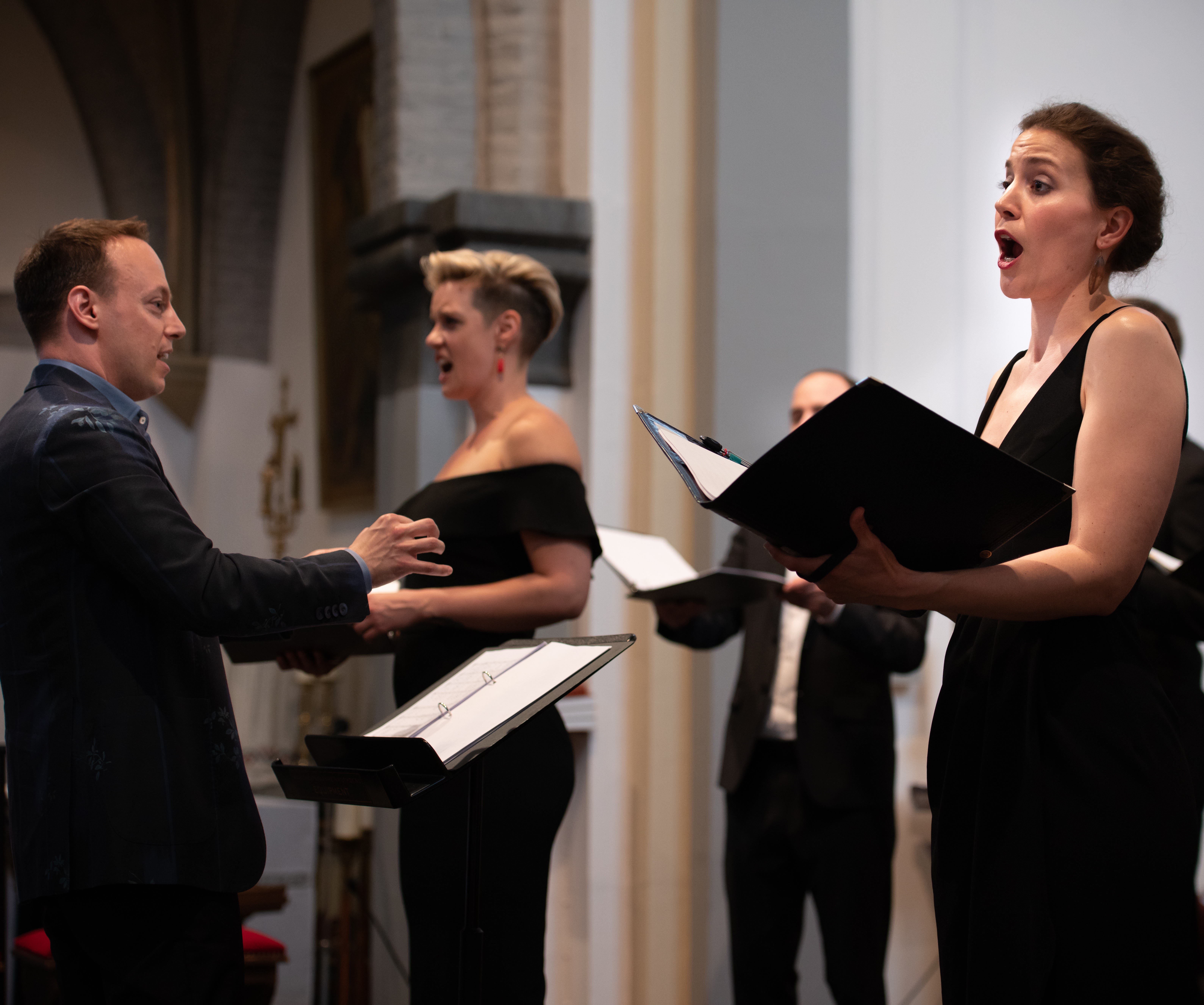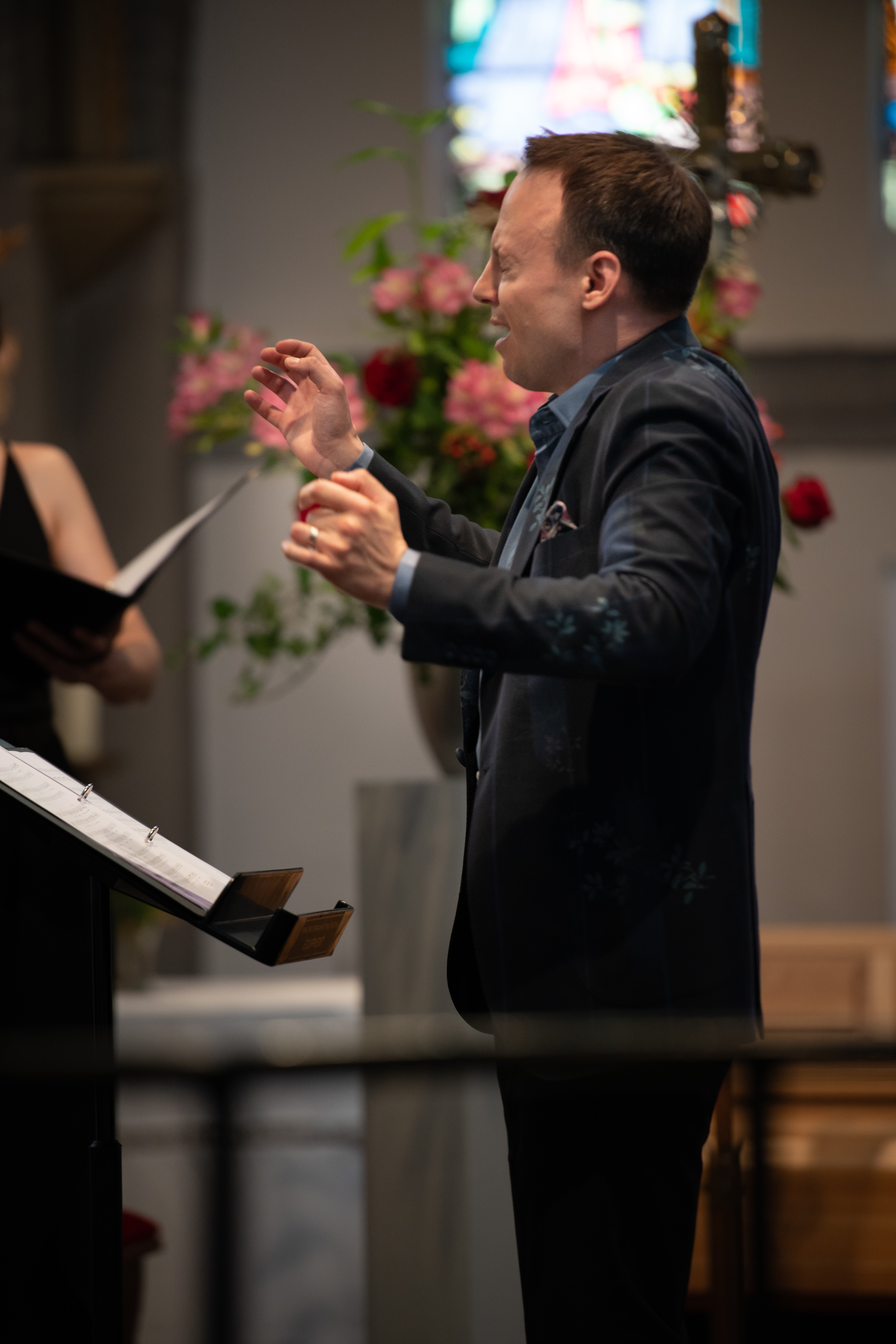Rodin Brings Renaissance Songs of Love
Just in time for Valentine’s Day—our annual tribute to the heart this year reaches back to the 15th century, as SFEMS welcomes Cut Circle, directed by Jesse Rodin. Concerts take place the weekend of February 8–10 in Berkeley, San Francisco, and Palo Alto.
 Founded in 2003 by Rodin, Associate Professor at Stanford University, Cut Circle specializes in late medieval and Renaissance choral music. In 2010 the ensemble received the Noah Greenberg Award recognizing outstanding contributions to historical performance practices. Cut Circle has also received the Prix Olivier Messiaen, Editor’s Choice (Gramophone) and a Diapason d’Or for its recent recording of Du Fay masses. The ensemble’s current recording projects include a double album devoted to the complete songs of Ockeghem. Rodin prepares new editions of all the music Cut Circle performs.
Founded in 2003 by Rodin, Associate Professor at Stanford University, Cut Circle specializes in late medieval and Renaissance choral music. In 2010 the ensemble received the Noah Greenberg Award recognizing outstanding contributions to historical performance practices. Cut Circle has also received the Prix Olivier Messiaen, Editor’s Choice (Gramophone) and a Diapason d’Or for its recent recording of Du Fay masses. The ensemble’s current recording projects include a double album devoted to the complete songs of Ockeghem. Rodin prepares new editions of all the music Cut Circle performs.
The ensemble, making their SFEMS series debut, aims to recapture the gritty, intense experience of singing early music. They commit to the music emotionally and physically, embracing confident singing, gripping contrasts, and energetic tempi. The ensemble’s approach is informed by deep knowledge of the music’s twists and turns as well as cutting-edge research that relies upon primary documents to unlock questions of performance practice.
The ensemble for these performances includes Clare McNamara and Kathryn Radakovich, discantus; Jonas Budris, Bradford Gleim, Lawrence Jones, and Steven Soph, altus & tenor; and Sumner Thompson and Paul Max Tipton, bassus.
“To love another—would humiliate my heart,” sings the devoted lover in Johannes Ockeghem’s famous “D’ung aultre amer,” evoking the power of love to captivate, nourish, and, on occasion, destroy. Love can be earthly and sensual; it can also be spiritual and divine, as when a Biblical figure is cast as the object of desire. “To Love Another…” will feature music of both romantic and spiritual intensity. In the following notes, director Jesse Rodin discusses the works they will perform.
* * *
 Our theme is love in its many guises—pure, slightly less pure, idealized, unrealistic, passive-aggressive, absurd, even raunchy. Don’t be put off by the old-fashioned language: behind the unfamiliar turns of phrase lie situations and emotions that have hardly changed since the fifteenth century.
Our theme is love in its many guises—pure, slightly less pure, idealized, unrealistic, passive-aggressive, absurd, even raunchy. Don’t be put off by the old-fashioned language: behind the unfamiliar turns of phrase lie situations and emotions that have hardly changed since the fifteenth century.
In the title piece (D’ung aultre amer) the speaker begins by considering—and then quickly rejecting—the idea of being disloyal. “By loving another my heart would demean itself,” he steadfastly sings, going on to assure us that he would never “exchange” his lover for someone else. The tone is high-minded, even chivalric, and yet he seems almost to protest too much.
More common, and more widely represented here, is unrequited love, music in which the “loving another” has already happened. In ¿Qu’es mi vida preguntays?, the speaker whines about being criticized for, well, whining about his plight: “Why do you ask me about / The pain I have to endure, / Since to love and lament / Is the life you give me?” In Se la face ay pale, the pale-faced lover goes so far as to contemplate suicide: “I find it / So bitter that in the sea / I would rather see myself.” In both cases we find lovers who have been spurned—and burned.
Not all fifteenth-century rejectees were so doleful. In L’autre d’antan, the lover seems capable of laughing at his own expense, sometimes using culinary metaphors: “In so bad a brew did she stir me . . . In such a fashion did she cook me.” Sillier still is the plainly rustic Une musque de Biscaye. Its gender politics will rub us the wrong way, but we can surely appreciate that it is the Basque maiden who has the last word. To every entreaty she replies (in a language her seducer cannot, alas, understand): “Get lost!”
 Perusing the program, you might reasonably wonder why we have asked lovers who are “bumping into me” and “knock[ing] me…into back of the pack” to rub shoulders with religious music glorifying Christ and the Virgin Mary. Nowadays Western art music tends to treat the secular and the sacred as entirely separate realms; concert programs and recordings cordon off vernacular songs from Latin-texted masses and motets so as not to offend anyone.
Perusing the program, you might reasonably wonder why we have asked lovers who are “bumping into me” and “knock[ing] me…into back of the pack” to rub shoulders with religious music glorifying Christ and the Virgin Mary. Nowadays Western art music tends to treat the secular and the sacred as entirely separate realms; concert programs and recordings cordon off vernacular songs from Latin-texted masses and motets so as not to offend anyone.
Fifteenth-century listeners had no such hang-ups. Vernacular love poetry could take on religious meanings if interpreted in a certain way; and “sacred” themes could have relevance in, or be debased by, all manner of “secular” contexts.
And so we begin with a motet in praise of the Virgin Mary (Virgo prudentissima) whose text is in fact inspired by the amorous (and in places highly explicit) Song of Songs. In Christe fili dei a love song is woven into the fabric of the polyphony, as Josquin’s altus quotes the corresponding song voice exactly. Still more thoroughgoing is the Stabat mater, where a song about a disconsolate woman is the glue that holds the piece together.
In Du Fay’s Missa Se la face ay pale, the tenor sings nothing but the tenor from the composer’s eponymous chanson. Indeed this stunning work, composed during the 1450s, is arguably the first great song-mass. Du Fay’s reliance on Se la face ay pale extends to passages in which all the voices participate in the chanson quotation: in such moments the mass almost literally turns back into the song.
Cut Circle’s sound: perfectly blended but passionate and gritty—brimming with raw energy.
As these examples make clear, many late-medieval listeners would have seen no contradiction between the earthly, sensual love of a rustic chanson and the high-minded, spiritual love of a Marian motet. For us the challenge is to set aside our cultural baggage in order to experience this flexible, porous attitude toward amorous themes. A first step along this path is opening ourselves up to the strong feelings these works inspired in their listeners. Just like us, they knew that love hurts.
* * *
Please note that because this concert is a co-presentation of Stanford Live, performance times, dates, and venues all are different from normal. Performances take place 8:00 p.m., Friday, February 8, at St. Mark’s Episcopal Church, 2300 Bancroft Way, Berkeley; 4:00 p.m. Saturday, February 9, at St. Mark’s Lutheran Church, 1111 O’Farrell at Gough, in San Francisco; and 2:30 p.m., Sunday, February 10, at Bing Concert Hall on the Stanford University campus in Palo Alto. Tickets are available online, through the SFEMS box office at 510-528-1725, or at the door 45 minutes before each performance. Single tickets for the Sunday, February 10th performance are only available by ordering directly from Stanford Live. (650-724-BING, 650-724-2464, Buy Stanford Tickets Online).












